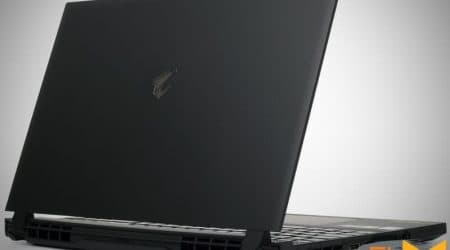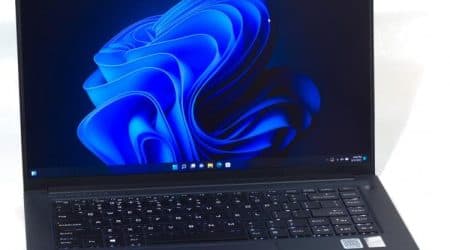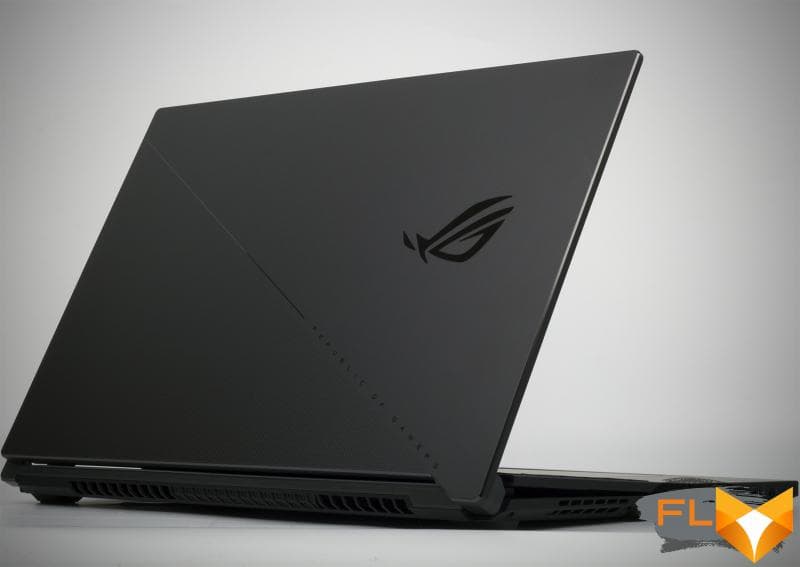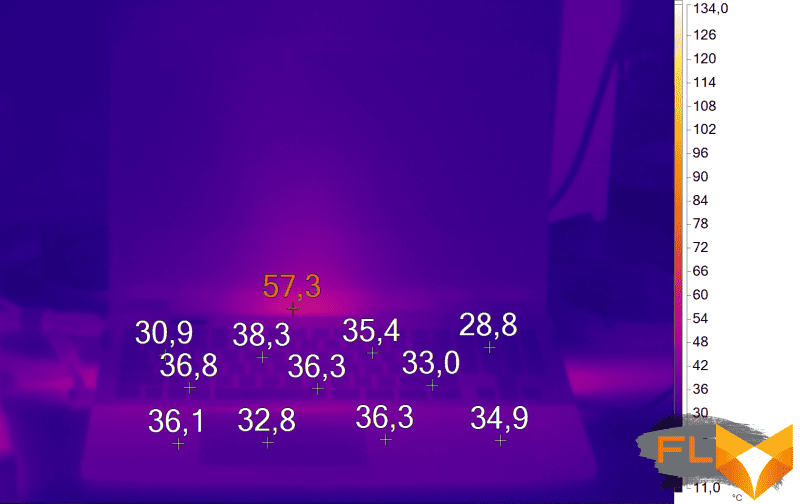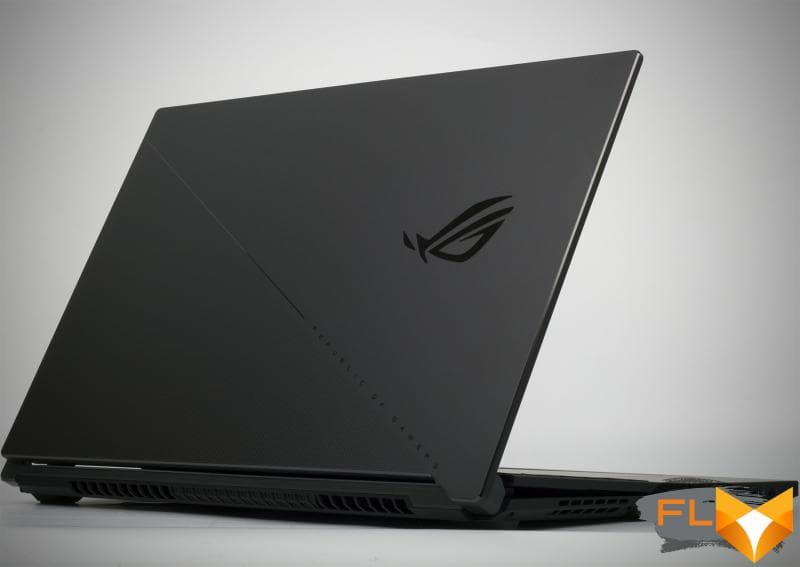


The ASUS ROG Zephyrus S17 GX703 model uses the mobile version of the NVIDIA GeForce RTX 3080 graphics card and the 8-core Intel Core i9-11900H processor. A laptop with such graphics – ROG STRIX SCAR 17 G733 – has already been a guest and, according to the results of the tests, received a good rating. Zephyrus should be just as powerful, but conceptually we are dealing with a different model. Let’s figure out what we were so hooked on by the next ASUS ROG book.
ASUS ROG Zephyrus S17 GX703
⇡#Specifications, equipment and software
If you believe the ASUS website, then on sale we will meet seven ROG Zephyrus S17 models at once. The graphics spread is large: from the GeForce RTX 3060 to the GeForce RTX 3080. Moreover, the flagship chip received 16 GB of video memory. The Dynamic Boost figures are also impressive: 140 W for older processors and 130 W for the GeForce RTX 3060. But there will be only two central processors: Core i9-11900H and Core i7-11800H, which are very similar in their characteristics. The full specifications of the ROG Zephyrus S17 are listed in the table below.
| ASUS ROG Zephyrus S17 GX703 | |
| Primary display | 17.3″, 2560 × 1440, IPS, 165Hz 17.3″, 3840 × 2160, IPS, 120Hz |
| CPU | Intel Core i7-11800H Intel Core i9-11900H |
| Video card | NVIDIA GeForce RTX 3080 16GB (140W with Dynamic Boost) NVIDIA GeForce RTX 3070 (140W with Dynamic Boost) NVIDIA GeForce RTX 3060 (130W with Dynamic Boost) |
| RAM | Up to 48GB DDR4-3200 |
| Install Drives | 3 × M.2 in PCI Express x4 3.0 / SATA 6Gb/s mode |
| Interfaces | 3 × USB 3.2 Gen1 Type-A 1 x Thunderbolt 4 1 x USB 3.2 Gen2 Type-C 1 x 3.5mm mini jack 1 x HDMI 1 x RJ-45 1 x microSD |
| Built-in battery | 90 Wh |
| External power supply | 280W |
| Dimensions | 394 × 264 × 20 mm |
| Notebook weight | 2.6kg |
| Operating system | Windows 10 Home Windows 10 Pro |
| Warranty | 2 years |
| USD price | From 3300 for Core i9 and GeForce RTX 3080 model. |
 | 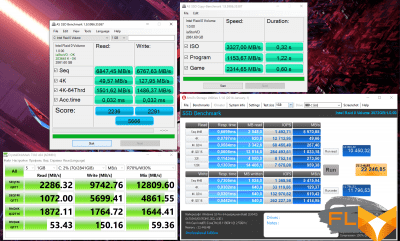 |
The most advanced version of the ROG Zephyrus S17, the GX703HS-KF015R, has arrived. It uses 32 GB of DDR4-3200 RAM and three terabyte NVMe SSDs at once, combined into a RAID array. It is known that in the first wave, top-end versions (with Core i9 and GeForce RTX 3080) will be available at a price of $3,300.
The laptop has a MediaTek MT7921 wireless module that supports IEEE 802.11b/g/n/ac/ax standards, as well as Bluetooth 5.2.

The ROG Zephyrus S17 comes with a large 280W external power supply. Together with all the wires, its weight is a little more than 900 g.
⇡#Appearance and Input Devices
The latest Zephyrus tested by the editors were the ROG Zephyrus G14 GA401 and ROG Zephyrus G15 GA503. The concept of such laptops is obvious: the manufacturer offers thin and light (in its class) laptops, which are nevertheless equipped with fairly powerful gaming hardware. In part, this idea also touched the ROG Zephyrus S17 – but only in part.
 | 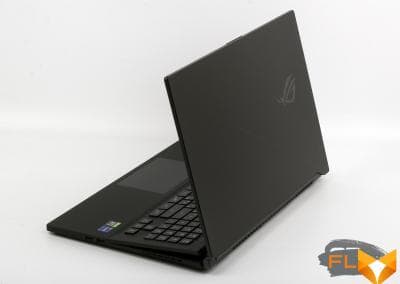 |
So, the thickness of the hero of the review is only 20 mm, and the weight does not exceed 2.6 kg. Before us is a rather compact “seed”, if these two words are generally appropriate to use in one sentence. Compactness is achieved not only due to the thickness of the body, but also due to the use of a display with thin frames: on top – 7 mm (and this time the webcam is in place), on the sides – 5 mm. In terms of weight, the ROG Zephyrus S17 is only 100 grams lighter than the previously mentioned ROG STRIX SCAR 17.

The body of the device is made of magnesium-aluminum alloy. The area around the keyboard is equipped with a soft-touch coating, and the display lid received a dotted pattern, however, it does not attract attention at all. The surface of the case is said to be resistant to dirt.
As a result, ROG Zephyrus S17 looks very strict – which is great.

A certain wow effect is created by the fact that when the display is opened, the panel with the keys slightly rises, tilting 5 degrees towards the user. The manufacturer claims that this provides comfort for the user’s hands and improves the cooling of the device itself. The raised keyboard has one more plus, but I will talk about it in the second part of the review.


On the left side of the laptop there was a power connector, HDMI output, RJ-45, USB 3.2 Gen2 A-type, Thunderbolt 4 (USB 4.0, combined with DisplayPort 1.4 and supporting Power Delivery 3.0 technology), USB 3.2 Gen2 C-type (combined with DisplayPort 1.4 and supports Power Delivery 3.0) and 3.5mm audio jack. On the right side, there are two USB 3.2 Gen2 A-types and an SD memory card slot. With functionality, the ROG Zephyrus S17 is in full order. The good news is that together with a laptop you can carry a small and light PSU – however, you will have to buy it separately.
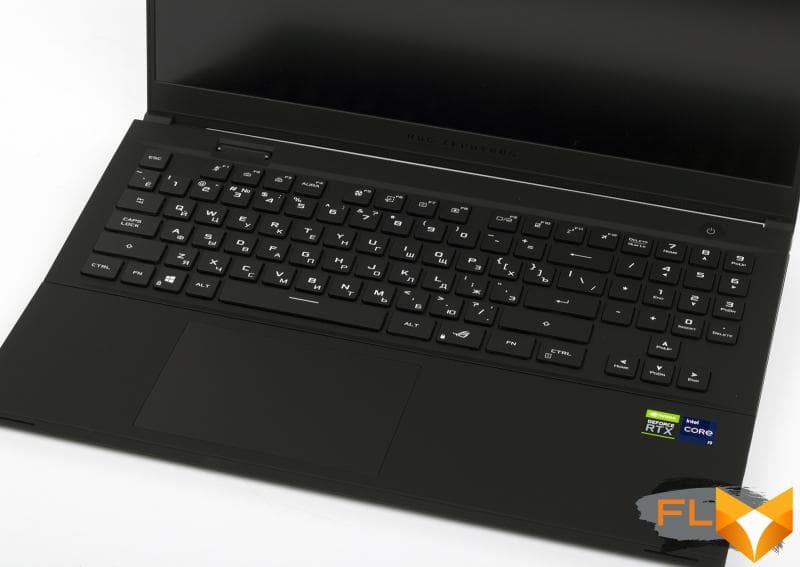
 | 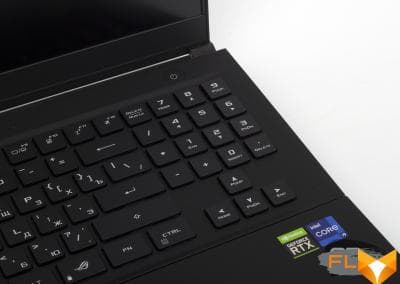 |
The panel raised by five degrees is, of course, fresh, original and unusual, but I was more impressed by the keys themselves and the ergonomics of the keyboard. Working and playing with ROG Zephyrus S17 is really very convenient. There is a digital block here, you will have to get used to the location of some buttons on it, but I don’t see anything wrong with that. But the keys are large – even the arrows, which ASUS engineers traditionally “shrink” in other models. It is convenient to use the F1-F12 range, a little sad from the lack of a Print Screen, but happy for the large Shift, Ctrl, Tab and Backspace – this is a brief description of the keyboard.
All keys are equipped with independent RGB backlighting – it is configured in the appropriate application of the laptop. The travel depth of each button is 1.9 mm – opto-mechanical switches are used with a press registration of 0.2 ms. The area of the body of the main buttons has a slight concavity (0.15 mm), and pressing occurs with a loud click, clear operation and tangible feedback. For each key, a resource of 100,000,000 keystrokes is declared.
Separately, I note the presence of the Multiwheel controller – a wheel that can be programmed to execute various commands. With it, you can, for example, change the volume of the speakers and microphone and adjust the backlight.
I was pleasantly surprised by the touchpad, it is large (130 × 85 mm) – and this is its main advantage. It turns out to be quite convenient to use. However, for games, in any case, you will need to buy a good mouse in addition to the good keyboard already in the laptop.
⇡#Internal design and upgrade options
The cover of the ROG Zephyrus S17 is very easy to remove, but be aware that you will have to unscrew a few Torx screws.
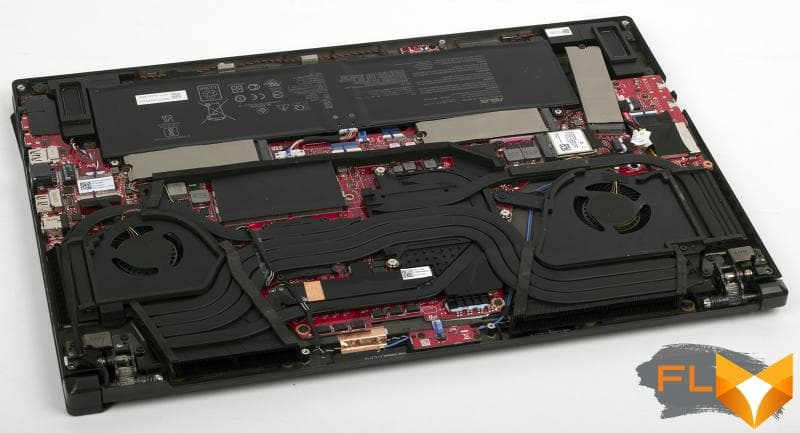
The laptop’s cooling system immediately received six heat pipes, four radiators and two tangential-type fans – ASUS calls the cooler aerodynamic (AAS Plus). A key feature of the CO is the opening air intake located under the keyboard. Its width is 12 mm, due to which the air flow is increased by 25%. At the same time, AAS Plus helps to reduce the noise level, according to the manufacturer, by 5 dBA in Turbo mode.
The heatsink’s copper fins are only 0.1mm thick, bringing the total to 250, for a total heat dissipation area of 133,537mm². Fans received 84 blades. The thickness of each lobe varies from base to edge to maximize airflow, while the wavy edges help reduce turbulence and therefore noise. The blades are made of liquid crystal polymer. The manufacturer claims a 13% increase in airflow at the same noise level as the previous generation of fans.
As always, ROG laptops use Thermal Grizzly liquid metal as the thermal interface for the CPU. For the correct application of this material, special equipment is used, which eliminates the possibility of error. In addition, the cooling block is designed to prevent liquid metal from leaking over time.

We’ve already noted that the crazy configuration of the ROG Zephyrus S17 has arrived, with three SSDs combined in a RAID array. In this case, Samsung MZVL21T0HCLR terabyte models are used. 16 GB of RAM soldered directly to the motherboard. Another 16 GB is provided by the SO-DIMM module. This means that by replacing the bar, we can increase the amount of RAM in the system from 32 to 48 GB.
⇡#Test Methodology
The testing methodology for gaming laptops puts even more emphasis on PC gaming. Laptop performance was measured using various software.
Games (Full HD, WQHD and Ultra HD resolution):
- World of Tanks EnCore RT. DirectX 11. Benchmark. Ultra mode, RT off
- Counter Strike: Global Offensive. DirectX 9. FPS Benchmark map. Multi-core processing – incl. Maximum quality.
- The Witcher III: Wild Hunt. DirectX 11. Novigrad and surroundings. Maximum quality.
- GTA V. DirectX 11. Built-in benchmark. Maximum quality, FXAA + 2x MSAA, advanced quality settings – on, 16x AF, image resolution scaling – off. In 4K – no AA.
- PlayerUnknown’s Battlegrounds. DirectX 11. Training mode. Ultra Mode
- Shadow of the Tomb Raider. DirectX 12. Built-in benchmark. Maximum quality, DXR – off, TAA.
- Assassin’s Creed Valhalla. DirectX 12. Built-in benchmark. Highest mode.
- Battlefield V. DirectX 12. The Last Tiger mission. Ultra Mode, TAA, DXR Off
- Red Dead Redemption 2. Vulkan. Built-in benchmark. Maximum quality (advanced settings – off), TAA.
- Gears 5. DirectX 12. Built-in benchmark. Ultra Mode
- Metro: Exodus. DirectX 12. Built-in benchmark. Ultra Mode
- Horizon Zero Dawn. DirectX 12. Built-in benchmark. Top quality, TAA.
- Death Stranding. DirectX 12 Prologue. Maximum quality.
- A Total War Saga: TROY. DirectX 11. Built-in benchmark. Max mode, 4x AA. In 4K – no AA.
- DOOM Eternal. Vulcan. Beginning of the game. Absolute Nightmare Mode
- Watch Dogs: Legion. DirectX 12. Built-in benchmark. Maximum quality, TAA, DXR off, DLSS off
- Cyberpunk 2077. DirectX 12. City trip. Impressive quality mode, DXR off, DLSS off
Gaming performance was measured using the well-known CapFrameX program. It allows you to get the rendering time of each frame. The use of the 99th percentile instead of the minimum frames per second is due to the desire to clean up the results from random performance fluctuations that were provoked by reasons not directly related to the operation of the main components of the platform.
Testing the laptop in games and applications was carried out with the activation of the fastest mode suitable for these tasks.
Applications:
- Corona 1.3. Testing rendering speed using the renderer of the same name. Measures the build speed of the standard BTR scene used to measure performance.
- Blender 2.92. Determining the speed of the final rendering in one of the popular free packages for creating three-dimensional graphics. The duration of building the final model pavillon_barcelona_v1.2 from Blender Benchmark is measured.
- x265 HD Benchmark. Testing the speed of video transcoding to H.265/HEVC format. The tables and graphs show the average integer value obtained after five runs of the test.
- CINEBENCH R23. Measuring the performance of photorealistic 3D rendering in the CINEMA 4D animation package, CPU test. The tables and graphs show the average integer value obtained after five runs of the test.
- Adobe Premiere Pro 2020 – Rendering a project in 4K resolution.
- Topaz Video Enhance AI v1.2.3. Performance testing in an AI-based program to improve video detail. The test uses the original video at 1280×720 resolution, which is scaled up by 150% using the Artemis-HQ model: P, HQ, MC.
Comprehensive benchmarks:
- Futuremark PCMARK10 Professional Edition 2.1.2177. Testing in Essentials scenarios (typical work of an average user: launching applications, surfing the Internet, video conferencing), Productivity (office work with a text editor and spreadsheets), Digital Content Creation (creation of digital content: photo editing, non-linear video editing, 3D rendering and visualization -models).
- 3DMark Professional Edition 2.11.6846. Testing in Time Spy and Fire Strike scenes.
- Unigine Superposition Benchmark. 1080p Extreme testing.
Notebook testing in resource-intensive applications was carried out in the default mode without any adjustment of the parameters of the central processor and cooler.
Display testing is performed using the X-Rite i1Display Pro colorimeter and the DisplayCAL 3 application.
The battery life of the laptop was tested in two modes. The first load option – web surfing – involves alternately opening and closing the tabs of the Computeruniverse.ru and Unsplash.com sites with an interval of 30 seconds. For this test, the current version of the Google Chrome browser at the time of testing is used. In the second mode, video in .mkv format and Full HD resolution is played in the built-in player of Windows OS with the repeat function activated. In all cases, the same display brightness was set to 200 cd / m2, and the keyboard backlight (if any) and the sound were turned off.
In games and other applications, the results of the following laptops are considered:
| Test participants | ||||||
| Model | Screen | Processor | RAM | Graphics | Drive | Battery |
| MSI GE66 Raider (2021) | 15.6”, 1920 × 1080 | Intel Core i7-10870H, 8/16 cores/threads, 2.2 (5.0) GHz, 45W | 16 GB DDR4-3200 Dual Channel | NVIDIA GeForce RTX 3070 Notebook 8GB GDDR6 | SSD 512 GB | 99.9 Wh |
| ASUS Zephyrus G15 | 15.6”, 2560 × 1440 | AMD Ryzen 7 5800HS 8/16 cores/threads 2.8 (4.4) GHz 35W | 16 GB DDR4-3200 Dual Channel | NVIDIA GeForce RTX 3070 Notebook 8GB GDDR6 | SSD, 1TB | 90 Wh |
| GIGABYTE AORUS 15G KC | 15.6”, 1920 × 1080 | Intel Core i7-10870H, 8/16 cores/threads, 2.2 (5.0) GHz, 45W | 16 GB DDR4-3200 Dual Channel | NVIDIA GeForce RTX 3060 Notebook 6GB GDDR6 | SSD 512 GB | 99 Wh |
| ASUS ROG Zephyrus G14 GA401 (2021) | 14”, 2560 × 1440 | AMD Ryzen 9 5900HS 8/16 Cores/Threads 3 (4.6) GHz 35W | 32 GB DDR4-3200 Dual Channel | NVIDIA GeForce RTX 3060 Notebook 6GB GDDR6 | SSD, 1TB | 76 Wh |
| ASUS TUF Gaming F15 (FX506H) | 15.6”, 1920 × 1080 | Intel Core i7-11800H, 8/16 cores/threads, 2.3 (4.6) GHz, 45W | 32 GB DDR4-3200 Dual Channel | NVIDIA GeForce RTX 3050 Ti Notebook 4GB GDDR6 | SSD, 1TB | 48 Wh |
| ASUS ROG Zephyrus S17 GX703 | 17,3″, 3840 × 2160 | Intel Core i9-11900H, 8/16 cores/threads, 2.5 (4.9) GHz, 45 W | 32 GB DDR4-3200 Dual Channel | NVIDIA GeForce RTX 3080 Notebook 16GB GDDR6 | SSD, 3TB | 90 Wh |
⇡#Display and sound
The versatility of the ROG Zephyrus S17 also comes into play when it comes to display choices, as you’ll find 4K and WQHD versions on sale. In the first case, there is support for Adaptive-Sync with a vertical frequency of 120 Hz. For the second display, support for G-SYNC technology is declared, and the screen refresh rate is 165 Hz. In our case (Ultra HD, 120 Hz, 3 ms), we are talking about an AUO B173ZAN061 IPS panel equipped with an anti-reflective coating.
The display is cool, but it, perhaps, lacks contrast a little. But the screen has a very high brightness and excellent color accuracy. So ROG Zephyrus S17 is suitable not only for entertainment, but also for content creation.
| ASUS ROG Zephyrus S17 GX703 (Matrix – AUO B173ZAN061) | |
| Minimum brightness | 26 cd/m2 |
| Maximum brightness | 479 cd/m2 |
| Color temperature | 6732K |
| Contrast | 867:1 |
| sRGB gamut | 100% |
| Adobe RGB color gamut | 86% |
| Grey scale deviation: average (maximum) | 1.06 (1.81) |
| Extended test deviation: mean (maximum) | 0.91 (3.82) |
| Viewing angles | corresponds to the declared |
| Glow effect | present |
| PWM | not seen at all brightness levels |
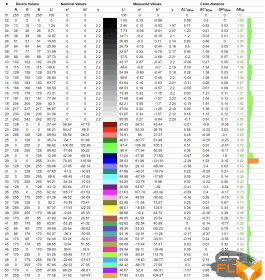 | 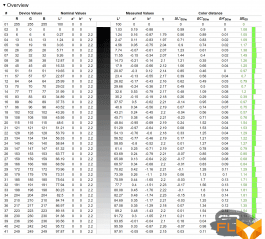 | 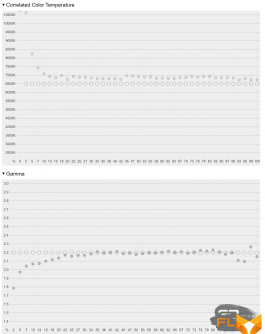 |
The Zephyr has the most excellent sound provided by six speakers at once. The volume reserve is very impressive. There are juicy bass, and sonorous highs, and tight mids – in terms of sound, this is the best gaming laptop that I have ever tested. And yet it is worth making a reservation that we are dealing with laptop sound, which, for obvious reasons, is inferior to the sound of many discrete audio systems.
⇡#Efficiency of the cooling system
Lots of heatpipes, big copper heatsinks, liquid metal—I personally had no doubt that the ROG Zephyrus S17 cooling system would do the job just fine.
With the help of the Armory Crate program and the function button on the keyboard, we can select different modes of operation. When running on battery, the default mode is “Quiet”, when working from the mains – “Turbo”. There is also an intermediate mode, which is called “Efficiency” (Performance). I tested the laptop in the last two, and entered the results in a table.
| Summary of laptop operation and setup | ||
| Laptop mode | Turbo | Performance |
| Declared GPU Speed (Boost) and Memory Speed | 1645 MHz, 14.3 Gbps | 1545 MHz, 14 Gbps |
| Cyberpunk 2077 Real GPU Clock: Min, Max, Average | 1590 MHz | 1365 MHz |
| 1710 MHz | 1710 MHz | |
| 1613 MHz | 1462 MHz | |
| Max noise level | 43.2 dBA | 40.5 dBA |
| Average Power: GPU, CPU | 139W | 127W |
| 23 W | 23 W | |
| GPU Temperature: Average, Maximum | 77 °C | 78 °C |
| 79 °C | 79 °C | |
| CPU temperature: average, maximum | 71 °C | 73 °C |
| 87 °C | 93 °C | |
| Performance | ||
| 3DMark Time Spy, points | 10971 | 10359 |
| 3DMark Fire Strike scores | 23516 | 21902 |
| Unigine Superposition, 1080p Extreme, points | 7543 | 7168 |
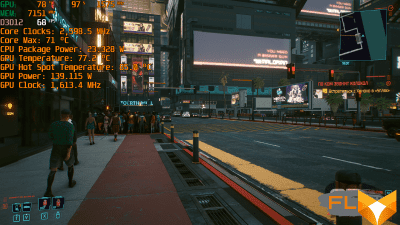 | 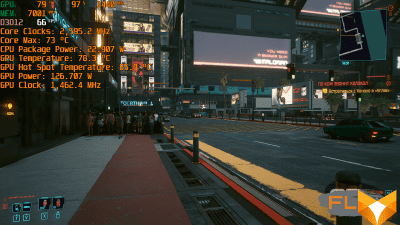 | |
Notebook case heating (games, nominal operation)
Once again, the ROG Zephyrus S17 cooler does a great job. In Dynamic Boost mode, the power consumption of the GPU is indeed 140 watts. At the same time, the GPU heats up to an average of 77 degrees Celsius. The processor does not overheat either, and the noise level, measured from a distance of 30 cm, was 43.2 dBA – this is loud, but, as for me, it is quite tolerable.
In Performance mode, the laptop is noticeably quieter. The heating of the ROG Zephyrus S17 components has increased, but this is due to the fact that the cooler fans do not spin up as much. And even in this mode, the laptop cannot be called hot: the maximum temperature of the GPU does not exceed 80 degrees Celsius; yes, there is a jump in CPU temperature, but on average the Core i9 does not heat up much.
And one more interesting fact: earlier we said that the laptop keyboard is slightly raised. The thermal imager clearly shows that such a design feature of the case does not allow the keyboard to get very hot – even in places where the chips are located.
While rendering video in Adobe Premiere Pro 2020, the temperature of the Core i9-11900H at its peak rose to only 86 degrees Celsius, and the average figure was 80 degrees. Recall: the PL1 threshold is 90 W, that is, it turns out that the chip is constantly working with this power. It’s no surprise that the performance of the ROG Zephyrus S17 has increased a lot, and thanks to the efficient cooler coupled with liquid metal. I also note that in the “Turbo” mode, the laptop turns out to be noisy.
| Laptop cooling efficiency in Adobe Premiere Pro 2020 | ||
| Turbo | ||
| CPU frequency | Medium | 4.3 GHz |
| CPU temperature | Maximum | 86 °C |
| Medium | 80 °C | |
| Noise level | Maximum | 43.3 dBA |
| CPU Power Consumption | Medium | 91W |
| Test task execution time (less is better) | 644 s | |
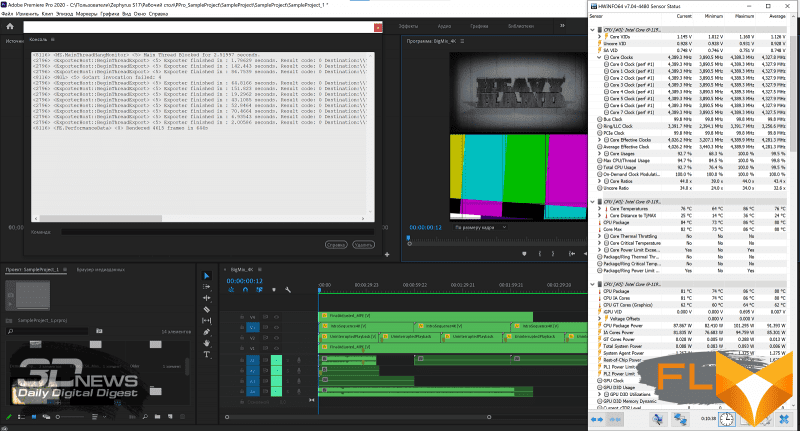
⇡#Laptop performance
Let me remind you that we have already tested a laptop with a powerful mobile version of the GeForce RTX 3080 – in the ROG STRIX SCAR 17 G733 model, the power consumption of the graphics chip reaches the declared 130 W in Dynamic Boost mode. In ROG Zephyrus S17, this parameter is 10 W higher. The difference is small, and therefore the results of these mobile computers are almost the same.
The difference in power consumption affects the performance of the laptop quite a bit. Look, the overall score in 3DMARK benchmarks for ASUS laptops is comparable. The fact is that we are dealing with processor-dependent applications for evaluating gaming performance. But in the Unigine Superposition benchmark, the test copy of the ROG Zephyrus S17 is ahead of the ROG STRIX SCAR 17 G733 by 3%.
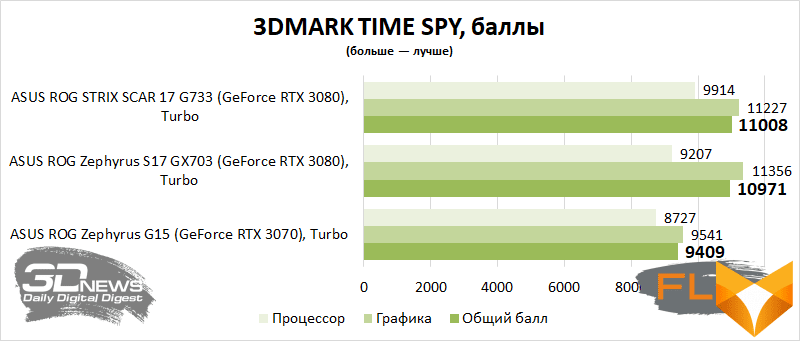
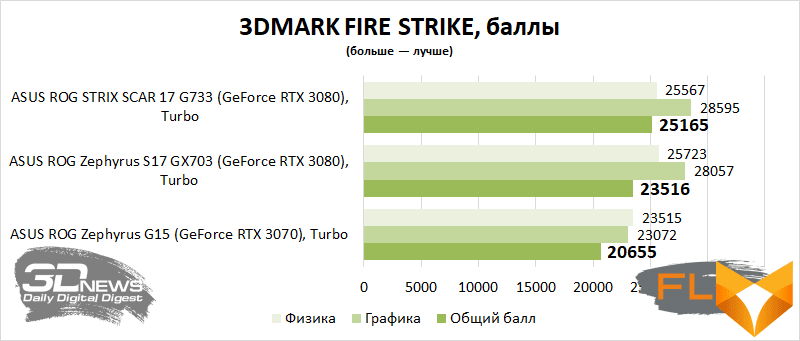
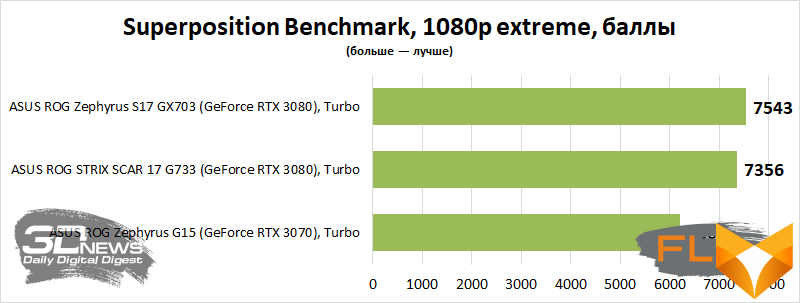
Naturally, the mobile GeForce RTX 3080 (yes, with 16GB of VRAM) is great for gaming at resolutions like Full HD and WQHD. Please note that in a number of projects there is processor dependence – the graphics are not 100% loaded. But there are also examples to the contrary.
However, the test version of the ROG Zephyrus S17 uses a 4K display. In this resolution, the laptop demonstrates a relatively comfortable (with drawdowns of at least 30 FPS) frame rate in 14 out of 17 cases. visual component. But it’s easier, in my opinion, to simply lower the resolution: in WQHD at 17 inches, the picture looks very dense and saturated.
| Test results in games, FPS (more is better) | ||||||
| Full HD | WQHD | Ultra HD | ||||
| AVG | 1% MIN | AVG | 1% MIN | AVG | 1% MIN | |
| World of Tanks | 258 | 169 | 170 | 116 | 86 | 60 |
| CS:GO | 458 | 142 | 341 | 91 | 190 | 45 |
| PlayerUnknown’s Battlegrounds | 193 | 136 | 165 | 118 | 105 | 65 |
| The Witcher III: Wild Hunt | 116 | 79 | 92 | 60 | 56 | 38 |
| GTA V | 92 | 65 | 77 | 57 | 62 | 46 |
| Shadow of the Tomb Raider | 79 | 49 | 77 | 49 | 51 | 40 |
| Assassin’s Creed Valhalla | 66 | 46 | 58 | 41 | 39 | 29 |
| Red Dead Redemption 2 | 77 | 62 | 62 | 51 | 41 | 33 |
| Gears 5 | 118 | 80 | 92 | 66 | 53 | 42 |
| Metro: Exodus | 81 | 42 | 63 | 39 | 42 | 28 |
| Death Stranding | 90 | 69 | 88 | 69 | 66 | 57 |
| A Total War Saga: TROY | 91 | 70 | 66 | 52 | 54 | 46 |
| Horizon Zero Dawn | 104 | 74 | 89 | 61 | 54 | 43 |
| Watch Dogs: Legion | 73 | 56 | 58 | 46 | 36 | 31 |
| Battlefield V | 135 | 83 | 105 | 68 | 59 | 46 |
| Cyberpunk 2077 | 74 | 52 | 51 | 37 | 26 | 21 |
| DOOM Eternal | 237 | 169 | 184 | 127 | 103 | 77 |
Powered up to 4+ GHz, the Core i9-11900H in a number of tests catches up and overtakes the Ryzen 9 5900HX, which in the ROG STRIX SCAR 17 G733 operates with an average power consumption of 79 watts. Both laptops make great mobile workstations if gaming isn’t your primary concern.
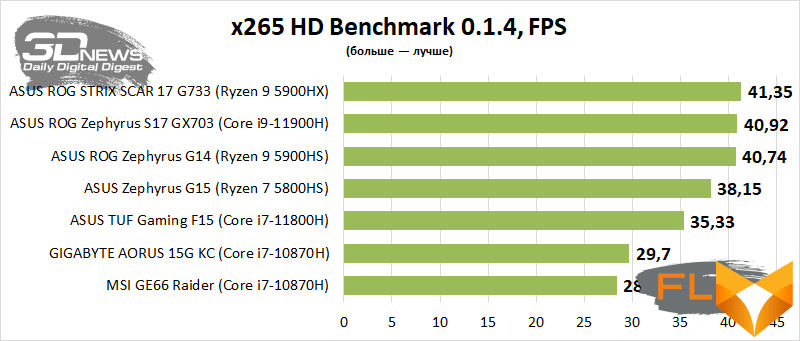


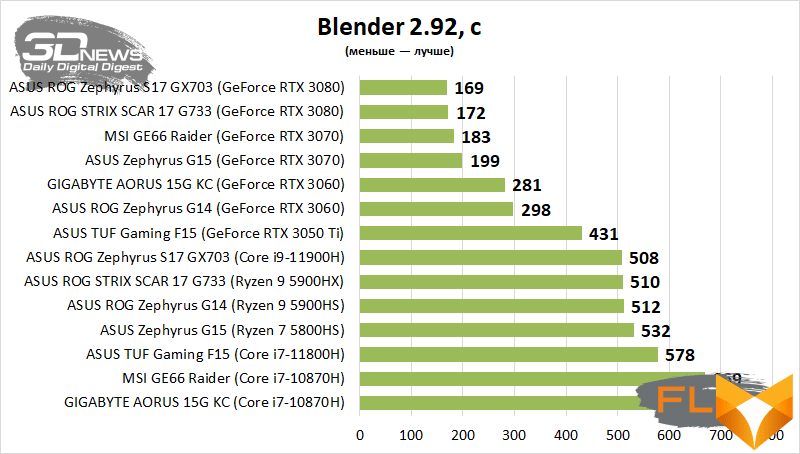
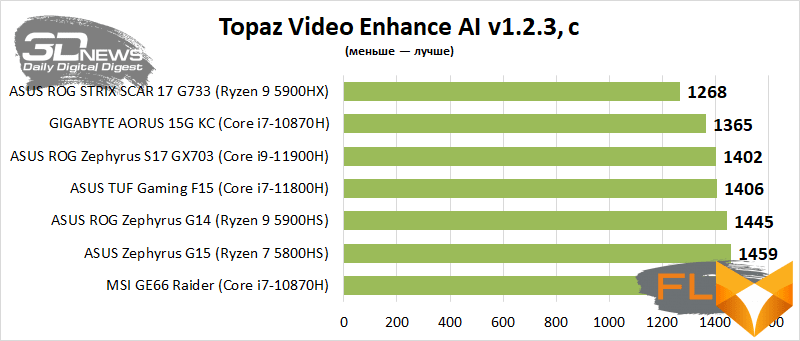

The presence of a RAID array, which includes three NVMe SSDs at once (in our case, this is the Samsung MZ-VL21T00), also seriously affects the performance of the laptop. In a number of tests (such as archiving, working with graphics and photo and video content, interaction with browsers, as well as office applications), it is the laptop drive that plays an important role. In the same PCMARK 10, which simulates the performance of typical home and office tasks, the ROG Zephyrus S17 is 2% ahead of the ROG STRIX SCAR 17 G733.

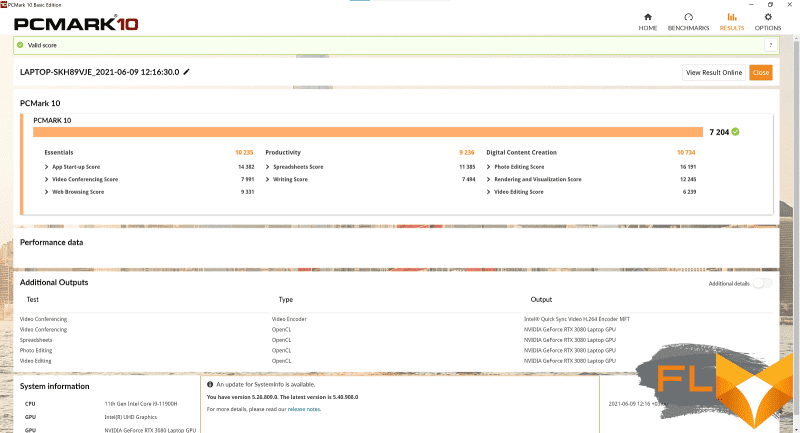
⇡#Laptop offline
ROG Zephyrus S17 versions come with a 90Wh battery. I’m not sure that the potential owner of such a laptop will constantly take it with him to work, school or somewhere else – after all, there are lighter and more compact mobile computers for this. And yet, if you need to be away from the outlet, then on a single battery charge, the test sample is able to work for almost 7 hours without recharging. The results are not record-breaking, but it is important to consider that we are dealing with a powerful laptop equipped with a rather energy-intensive 4K screen and three SSDs at once.
From 0 to 50% the battery is charged in just half an hour.
| Battery life, screen brightness 200cd/m2 | |
| Web | 6 hours 58 minutes |
| View video | 6 hours 44 minutes |
⇡#Conclusions
The ASUS ROG Zephyrus S17 GX703 is the flagship we deserve. ASUS engineers have done everything to use the most advanced Intel and NVIDIA components in it. Yes, the laptop cannot be called quiet, but personally I am completely satisfied with the impressive level of performance and low heating of powerful hardware in the face of the GeForce RTX 3080 and Core i9-11900H, which is given at the cost of this noise. At the same time, the configuration includes three fast Samsung SSDs and 32 GB of RAM at once.
The laptop received an excellent case: the functionality and build quality are not in question, and the keyboard lift mechanism is still ASUS know-how (remembering the Zephyrus GX501 / GX550 models) – very interesting and futuristic, by the way. There is a newfangled Thunderbolt 4 and other modern interfaces. There is a card reader here. The keyboard is comfortable and sprawling, though I wouldn’t say the 5 percent slope immediately puts it head and shoulders above the input devices of other large laptops. The screen is excellent and well suited not only for entertainment, but also for work. Finally, even the autonomy of the ROG Zephyrus S17 was not a failure.
Of course, this model (especially in this modification, GX703) will cost fabulous money. But I don’t see the point in not giving the tested device an Editors’ Choice award. ASUS ROG Zephyrus S17 deserves it.
